USA

Cities in USA
| Atlantic city | Boston | Dallas |
| Detroit | Las vegas | Memphis |
| Nashville | New york | Seattle |
Popular destinations USA
| Arizona | California | Florida |
| Hawaii | Utah |
Geography and Landscape
Geography
The United States of America, is a federal republic in North America, comprising the District of Columbia and 50 states, 49 of which are in mainland North America and one (Hawaii) in the Pacific Ocean. The total land area of the United States is 9,809,155 km², making it the largest country in the world after Russia and Canada.
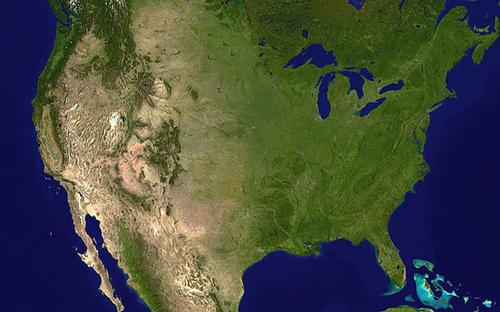 USA Sattelite photoPhoto: Public domain
USA Sattelite photoPhoto: Public domain
The United States borders Canada to the north (8,893 km, including 2,477 km border with Alaska), Mexico to the south (3,141 km), the Atlantic Ocean to the east, and the Pacific Ocean to the west. The land border with Mexico is half formed by the Rio Grande. The distance from New York to Los Angeles is almost 5000 kilometers.
Under the jurisdiction of the United States: the Commonwealth of Puerto Rico (Puerto Rico), the Virgin Islands, Guam, American Samoa, a number of small, often uninhabited islands in the Pacific, the Trust Territory of the Pacific Islands and the Commonwealth of the Northern Marianas (Northern Mariana Islands), in total approx. 11,155 km².
Part of California in the southwest is exactly on the St. Andreas fault. As a result, there is an increased risk of earthquakes in this area.
Landscape
On the eastern side of the American continent, the Appalachians stretch from Atlanta to Cape Gaspé in Canada. In the east this mountain consists of a low plateau, the Piedmont, and a steeply rising mountain ridge, the Blue Ridge with Mount Mitchell (2037 meters) as the highest point in the south. The central part consists of a number of parallel ridges between which there are wide valleys, the Valley and Ridge Region. The west side is closed off by a high steep edge, the Alleghany Mountains.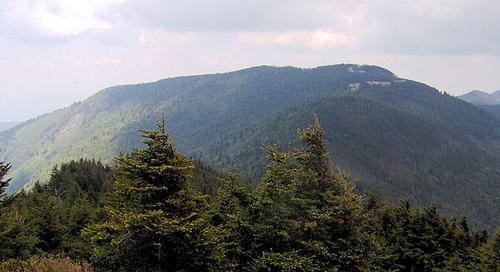 Mount Mitchell, highest point of the USA east of the MississippiPhoto: Brian Stansberry CC 3.0 Unported no changes made
Mount Mitchell, highest point of the USA east of the MississippiPhoto: Brian Stansberry CC 3.0 Unported no changes made
The flat central part of the United States has been lifted but hardly folded due to the folding and lifting of the Rocky Mountains. This has created a landscape of a predominantly flat land that gradually rises to the foot of the Rocky Mountains. Giant prairies stretch from Ohio and Missouri to the east, through Illinois and Wisconson, Minnesota, Iowa, and northern Missouri, then spread into Central Texas, Oklahoma, Kansas and eastern Nebraska and southern and North Dakota. The low part west of the Mississippi has almost completely turned into an agricultural area, the so-called "Corn Belt". The high part is a dry steppe at the foot of the Rocky Mountains at about 1500 kilometers. Large rivers such as Missouri, Platte River and Arkansas have cut wide valleys. This great plain is interrupted in the states of Missouri and Arkansas by the Ozark Plateau, a continuation of the Appalachians.
The Gulf Coast is a large silt area that extends into the Florida peninsula. Along the Atlantic coast, this sandy plain continues to Cape Cod.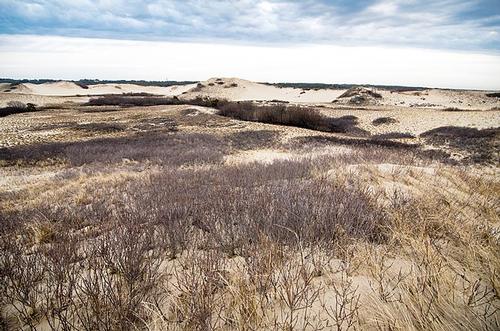 Sandy Cape Cod, USAPhoto: M01229 CC 2.0 Generic no changes made
Sandy Cape Cod, USAPhoto: M01229 CC 2.0 Generic no changes made
In the west, the Cordillera rises 2000 meters above the Great Plains. This vast mountain range extends from the far north of the American continent, the heavily glaciated Brooks Range, to the Sierra Madre del Sur in Mexico; in fact, it also continues in the Andean chain in South America. The eastern chain of the Cordillera is formed by the Brooks Range, the Mackenzie Mountains, the Rocky Mountains and the Sierra Madre Oriental.
There are a number of high plains to the west of this chain. This leads to a number of ridges, creating smaller basins, which in some cases have no outflow to the sea, so that salt lakes, such as Great Salt Lake, are formed.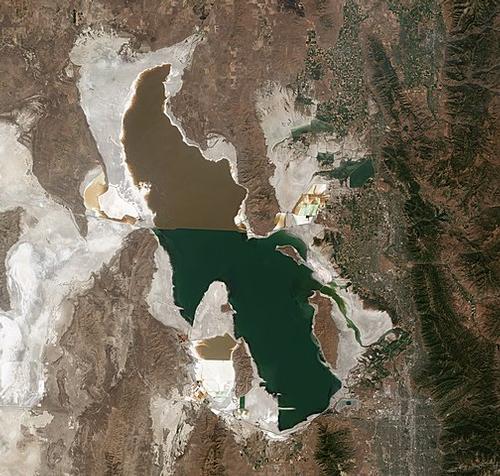 Great Salt Lake, Utah, USAPhoto: Copernicus Sentinel-2, ESA CC 3.0 IGO no changes made
Great Salt Lake, Utah, USAPhoto: Copernicus Sentinel-2, ESA CC 3.0 IGO no changes made
The Great Plains lie to the west of the invisible line that clearly divides the North American continent in two: the 508 mm precipitation line, one of the major geographical divisions in the United States. This line, which runs almost straight through the center of the country from north to south, separates the more inhospitable east from the dry west, which lies in the rain shadow of the Rocky Mountains, with its unpredictable and low rainfall, its harsh climate and smaller , more dispersed population.
The land between the Rocky Mountains and the Sierra Nevada in the west is dry: the sun burns most of the year, the mercury can rise above 50 °C in the shade, and even fairly large mountain rivers dry up quickly. In this part of the country is also "the bottom of the United States", Death Valley. This ancient lake bottom, nowadays a desert of more than 200 kilometers in length, lies 830 meters below sea level.
The rivers have cut huge canyons in these high plains; famous is the Grand Canyon of the Colorado River. The Grand Canyon in Arizona is the deepest canyon in the world, 446 kilometers long and an average of 1.6 kilometers deep. To the west, this plateau is closed by a mountain range with a steep east side and a less steep west side: Alaska Range, St. Elias Mountains, Coast Range, Cascade Range, Sierra Nevada and Sierra Madre Occidental. In the north of the continent, this chain forms a real fjord coast, with large glaciers sliding into the sea, especially in Alaska. Further south there is a coastal mountain range for this, in the United States a closed mountain range that closes off the Willamette Valley and the Valley of California. Even further south, it separates the Gulf of California from the Pacific.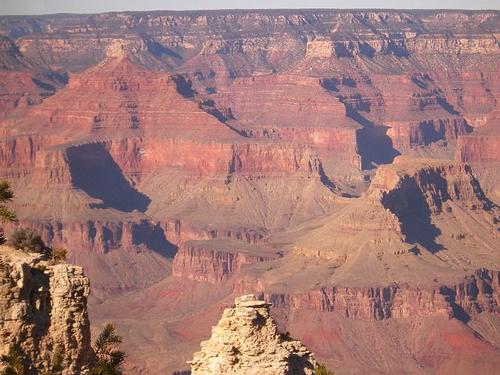 Grand Canyon, Arizona, USAPhoto:Diego Delso CC-BY-SA no changes made
Grand Canyon, Arizona, USAPhoto:Diego Delso CC-BY-SA no changes made
Alaska, the 49th state, is a different story in landscape terms. Alaska consists of ice. Under the ice and snow layers, the ground is frozen to a depth of 90 meters. Even in summer, when the sun is practically not setting, the bottom does not thaw below 60 centimeters. In the far north the temperature can drop to below 40 °C, in the south the winters are more bearable.
In Central Alaska is Mount McKinley, the highest mountain in all of North America with approximately 6200 meters. Outside of Alaska, Mount Whitney in California is the highest mountain at 4,418 meters.
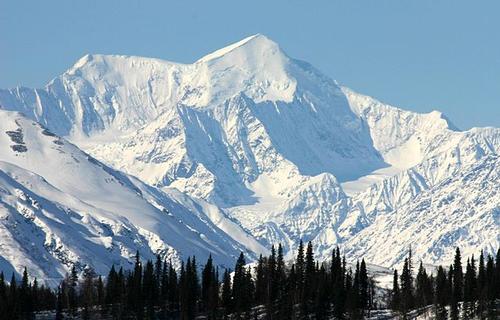 Mount McKinley, highest mountain of the USAPhoto: Frank K. CC 2.0 Generic no changes made
Mount McKinley, highest mountain of the USAPhoto: Frank K. CC 2.0 Generic no changes made
Hawaii, the 50th state, cannot be compared to the other states either. The eight large and about a hundred small islands are spread over a length of 2500 kilometers in the Pacific. The island closest to the American coast is about 3,200 kilometers from San Francisco. The largest island is Hawaii and has five volcanoes, two of which still operate. The 4200 meter high crater of the Mauna Loa is the largest active volcano in the world.
On the mainland there are also a number of large volcanoes active such as the Katmai (ALaska Range), Mount Rainier (Cascade Range), Mount Lassen and Mount Shasta (Sierra Nevada). The state of Alaska has approximately 70 active volcanoes. Every year about 5,000 earthquakes and sea tremors also occur, some of which are very severe. On March 27, 1964, an 9.2-magnitude earthquake occurred 120 kilometers southeast of Anchorage.
Rivers and lakes
The water balance of the United States is primarily determined by the relief. The main river basins are located in the central lowland.An important hydrographic area are the great lakes on the border of the United States and Canada. With a total area of approximately 250,000 km², this is the largest freshwater basin in the world. The lakes are interconnected by rivers and connected to the sea via the St. Lawrence River.
The biggest difference in height exists between Lake Erie and Lake Ontario. This height difference is overcome by Niagara Falls, waterfalls that can be counted as the largest in the world in terms of water mass. The heights of the American Fall and the Canadian Fall are not that spectacular in themselves, 52 and 48 meters respectively. Yosemite National Park is home to one of the world's tallest waterfalls, the Ribbon (491 meters).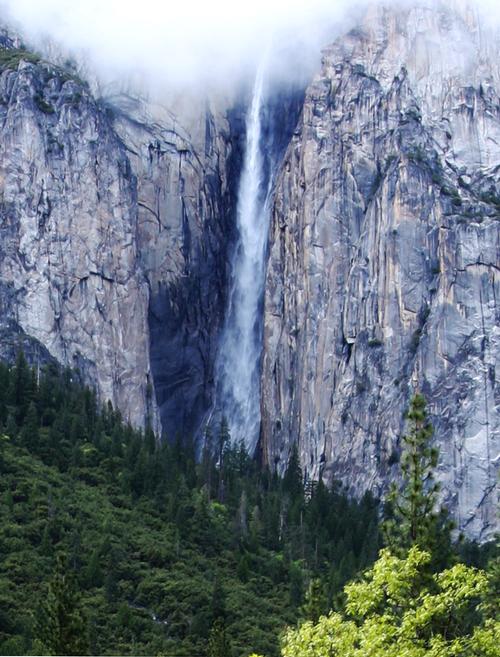 Ribbon Waterfall, highest of the USAPhoto: Rennett Stowe CC 2.0 Generic no changes made
Ribbon Waterfall, highest of the USAPhoto: Rennett Stowe CC 2.0 Generic no changes made
A number of short rivers flow from the eastern edge of the Appalachians to the Atlantic Ocean. The largest river basin in the United States is that of the Mississippi. It includes the central lowland south of the Great Lakes, the west side of the Appalachians, and much of the east side of the Rocky Mountains.
The Mississippi has its source on the Mesabi Range and is navigable from the Anthony Fall near Minneapolis. The decline is small and after the incorporation of the Missouri and the Ohio, the river goes to the sea like a mile wide stream with great meanders.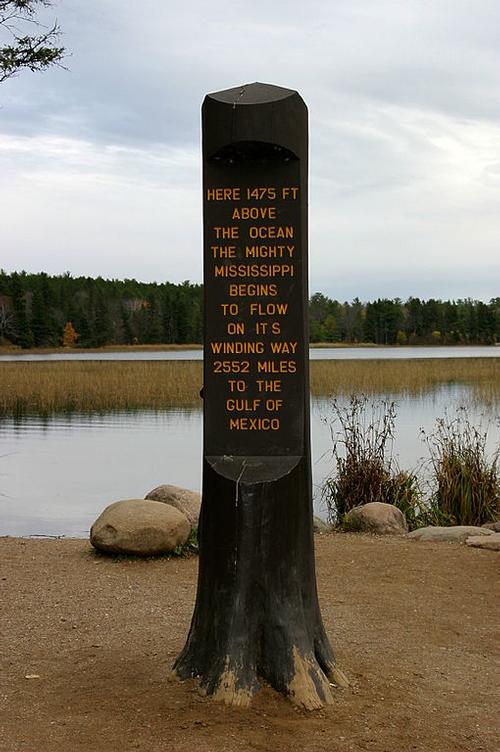 Mississippi starts flowing in Itasca State Park, Minnesota, USAPhoto: Mark Evans s CC 2.0 Generic no changes made
Mississippi starts flowing in Itasca State Park, Minnesota, USAPhoto: Mark Evans s CC 2.0 Generic no changes made
The Rio Grande, flowing through one of the driest areas of the Great Plains, has great significance for irrigation. The rivers of the west side of the Rocky Mountains often go through deep canyons through the plateaus of the Great Basin. Most famous is of course the Grand Canyon, which is cut out by the Colorado River.
Longest rivers (* = partially flowing through Canada)
| Missouri | 4086 kilometer |
| Mississippi | 3765 kilometer |
| Yukon* | 3185 kilometer |
| Rio Grande | 3057 kilometer |
| St.Lawrence* | 3057 kilometer |
| Arkansas | 2349 kilometer |
| Colorado | 2333 kilometer |
| Atchafalaya | 2285 kilometer |
| Ohio | 2108 kilometer |
| Red River | 2076 kilometer |
| Brazos | 2060 kilometer |
| Columbia | 1995 kilometer |
| Snake River | 1673 kilometer |
| Platte River | 1593 kilometer |
| Pecos | 1490 kilometer |
| Canadian | 1458 kilometer |
| Tennessee | 1426 kilometer |
| Colorado | 1329 kilometer |
| North Canadian | 1287 kilometer |
| Mobile | 1245 kilometer |
| Kansas | 1195 kilometer |
| Kuskokwim | 1165 kilometer |
| Yellowstone | 1113 kilometer |
| Tanana | 1060 kilometer |
| Milk | 1006 kilometer |
| Quachita | 973 kilometer |
| Hamilton | 965 kilometer |
| Cimarron | 965 kilometer |
Sources
Phillipson, O. / USA
Heinemann Library
Sandak, C.R. / Verenigde Staten van Amerika
Corona
Stanic, S. / De Verenigde Staten
Schuyt & Co
Supermachten
Stichting Teleac 1: Verenigde Staten van Amerika
Verenigde Staten
Uitgeversmaatschappij The Reader’s Digest NV
Webb, M. / The United States
Lucent Books
CIA - World Factbook
BBC - Country Profiles
Last updated November 2025Copyright: Team The World of Info